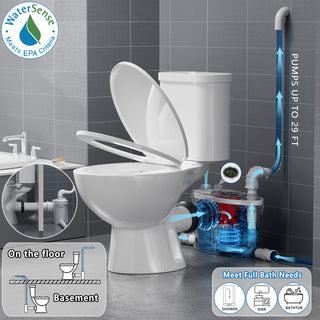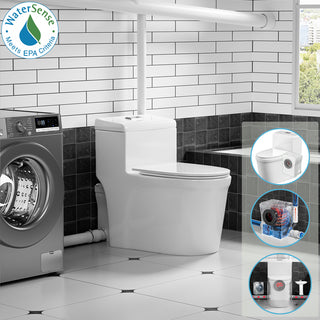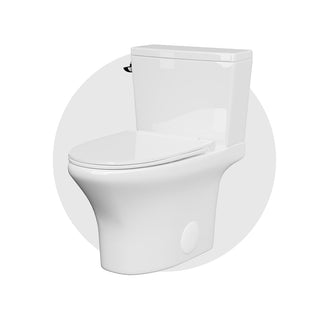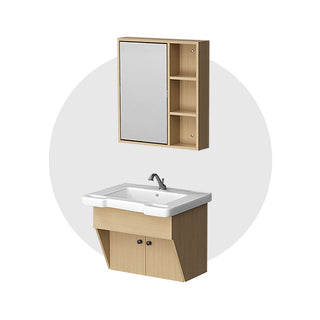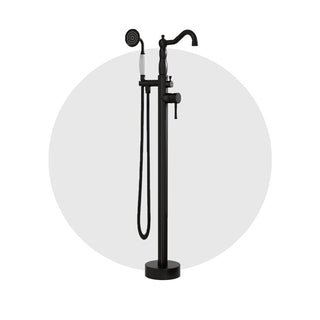Toilet height might seem like a small detail—until you realize it can make a big difference in comfort, safety, and even legal compliance. Whether you're upgrading a bathroom at home or renovating a public space, understanding the differences between ADA-compliant, comfort height, and chair height toilets is key to making the right choice.
Let’s break down what each term means, how tall these toilets actually are, and who they're really for.
I. What Is an ADA Toilet?
An ADA-compliant toilet meets the requirements outlined by the Americans with Disabilities Act (ADA). This includes:
- Seat height: 17″–19″ measured from floor to top of the seat
- Clearance space: Enough room beside the toilet for wheelchair access (minimum 60" turning radius and 16"–18" from centerline to wall for side approach)
- Flush controls: Must be easy to reach (within 44″ from the floor), operable with one hand, and not require tight grasping or twisting
- Grab bar placement: At least one horizontal grab bar behind or beside the toilet, mounted 33″–36″ from the floor
These specifications are mandatory in commercial or public restrooms designed to meet accessibility standards. ADA toilets are also commonly used in accessible home renovations, especially for aging in place.
II. What Is a Comfort Height Toilet?
“Comfort Height” is a term popularized by brands like Kohler to describe toilets with a seat height in the 17″–19″ range, similar to a standard chair. The goal? Easier sitting and standing—especially for taller users, older adults, or those with mobility issues.

Though not a legal term, most comfort height toilets meet ADA height standards and are often marketed as “ADA height” for residential use.
👉 Want more details? See our post: How Tall Is a Comfort Height Toilet?
III. What Is a Chair Height Toilet?
“Chair Height” is essentially the same thing as comfort height—it’s just a different term used by brands like American Standard and TOTO. These toilets also sit between 17″ and 19″ at the seat, and are designed to mimic the feel of sitting on a regular chair.

👉 Read more: How Tall Is a Chair Height Toilet?
IV. ADA vs. Comfort vs. Chair Height: Comparison Table
|
Term |
Seat Height |
Legal Definition |
Typical Use |
ADA Compliant? |
|
ADA Toilet |
17″–19″ |
✅ Yes (federally defined) |
Public, commercial, ADA renovations |
✅ Required |
|
Comfort / Chair Height |
17″–19″ |
❌ No (descriptive terms) |
Homes, seniors, general accessibility |
✅ Often compliant |
| Note: “Comfort Height” and “Chair Height” refer to the same height range—just different terms used by different manufacturers.
V. Which Toilet Height Should You Choose?
If you're designing for a commercial space or a public restroom, you'll need to choose a certified ADA toilet to ensure full compliance—not just in height, but also in layout and controls.
For residential bathrooms, there’s more flexibility. Comfort and chair height toilets are widely used in homes because they offer similar height benefits without being strictly regulated. They’re especially helpful for:
- Seniors
- Tall users
- People recovering from surgery or dealing with mobility challenges
VI. FAQs
Q: How tall is an ADA toilet?
ADA requires a seat height between 17″ and 19″, including the seat.
Q: Is Comfort Height the same as ADA height?
In terms of height, yes—both refer to a seat height between 17″ and 19″. However, for public or commercial use, look for certified ADA compliance.
Q: How tall is a Chair Height toilet?
Chair Height is typically 17″–19″, same as Comfort Height, ADA Height.
Q: Can a toilet be taller than ADA height?
Yes. While ADA standards require a seat height between 17″ and 19″ for compliance, some toilets go beyond that for added comfort. These taller models can be especially ideal for home use—particularly for taller individuals or those who need easier sit-to-stand support.


